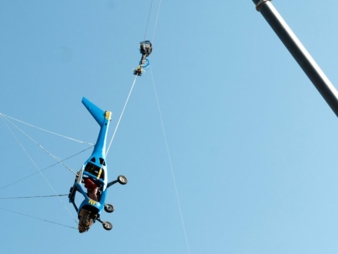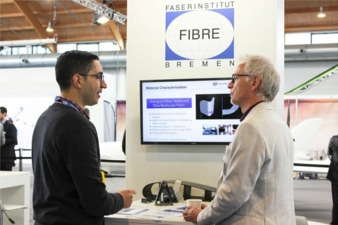12/06/2019 – FIBRE – Bremen Fibre Institute — auf Deutsch lesen
Crash-safe design for light aircraft
The Bremen Fibre Institute took some of its fibre-based expertise to Friedrichshafen where, from 10 to 13 April, innovations in the field of light aircraft and drones were on display at the Aero industry fair.
Also manning the shared stand of the Hamburg-managed Aviares Network was FIBRE employee Adli Dimassi (32), who specialises in modelling and simulations.
Dimassi, an expert in aerospace technology, works as a scientist at the Institute in Bremen. He is currently working on the SafetyBox project, where his focus is on the simulation and predicted behaviour of crash structures in light aircraft.
The objective of this project, supported by innovation funding from the German Ministry of the Economy and carried forward by a number of industry partners, is to develop a means of strengthening the fibre-reinforced plastic (FRP) structures of the airframe using recycled long fibres, amongst other materials, to form an economical safety capsule. This capsule would absorb a large quantity of energy in the case of an accident, and thus offer greater protection to those inside. The statistics show how desperately this is needed: in the year 2012 alone, 79 aircraft of under 2,000 kg suffered accidents resulting in 36 deaths, while in 2016 there were another 57 such accidents and 19 fatalities.
By way of example, the project partners developed an especially crash-safe design for the C4 aircraft produced by the Eisenach-based ultra-light aircraft manufacturer, Flight Design. At its heart were crash elements to absorb energy, including a stiffened cabin, improved undercarriage and a modified seating system. To protect the occupants in the case of fire, the SafetyBox would in addition carry a heat- and fire-resistant coating.
Adli Dimassi, who gave a presentation on this development in Friedrichshafen, masterminded the optimisation of components by investigating the failure behaviour of individual crash elements and the main undercarriage, using experiments and simulations.
To test the new cabin with its strengthened fuselage, a crash experiment was performed at the Ostfalia University of Applied Sciences in Wolfenbüttel, Lower Saxony. An aircraft fuselage suspended from a crane was crashed into the ground at an angle of descent of 34 degree and a speed of close to 88 kilometres an hour. The angle and speed represent the boundary between non-fatal and fatal incidents.
The result
The structure met most of the requirements and the cabin showed no signs of damage that would be dangerous to passengers. It also prevented the engine block from penetrating the cabin during the crash, which could have threatened the safety of the passengers. Following the test, further work was announced to reduce the effects of acceleration on the human body in accidents of this kind.
Dimassi values his involvement in such research work: “This project is giving young scientists the ability to acquire skills in the field of occupant safety in light aircraft, and to make a contribution to the air travel of the future.”
Aero Friedrichshafen
The International Aviation Fair at Friedrichshafen, on the shores of Lake Constance, drew to a close in April with record numbers of exhibitors and visitors. Nearly 760 companies and research institutes, including the Bremen Fibre Institute, and 32,000 industry visitors from 40 countries were represented at the world’s leading general aviation trade fair.
FIBRE
The Bremen Fibre Institute (FIBRE) is a highly successful research institute involved in the development of high-performance composites, production technologies, fibre development, quality assurance, and material development and characterisation.





